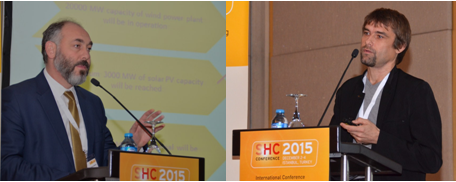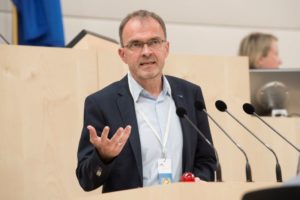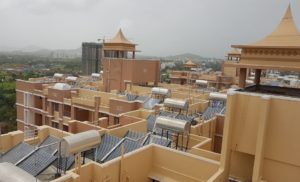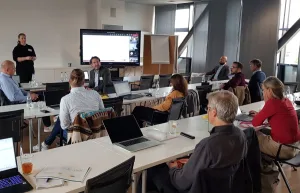

Meet Where the Continents Meet: SHC2015 in Istanbul
 Two continents meet in Istanbul, in a metropolis of 15 million. More than 230 researchers and industry representatives from five continents used this strategic spot for their participation in SHC2015, a high-level conference which took place at the beginning of December and focused on solar heating and cooling technologies as well as their related markets. The three-day event organised by the IEA Solar Heating and Cooling Programme in cooperation with the German company PSE and the European Solar Thermal Industry Federation (ESTIF) presented a mix of technological innovations, the latest research results, service tools for planners and designers of complex solar heating and cooling installations, and it offered a lot of room for discussions on market and technology developments from different countries and regions. This news piece will highlight some of the key aspects of the conference and will be followed by a number of solarthermalworld.org articles over the coming weeks, each with their own special focus.
Two continents meet in Istanbul, in a metropolis of 15 million. More than 230 researchers and industry representatives from five continents used this strategic spot for their participation in SHC2015, a high-level conference which took place at the beginning of December and focused on solar heating and cooling technologies as well as their related markets. The three-day event organised by the IEA Solar Heating and Cooling Programme in cooperation with the German company PSE and the European Solar Thermal Industry Federation (ESTIF) presented a mix of technological innovations, the latest research results, service tools for planners and designers of complex solar heating and cooling installations, and it offered a lot of room for discussions on market and technology developments from different countries and regions. This news piece will highlight some of the key aspects of the conference and will be followed by a number of solarthermalworld.org articles over the coming weeks, each with their own special focus. Photos: Eva Augsten
Turkey – second-largest market worldwide: “In Turkey, we have a strong supply chain to the customer with around 3,000 specialised solar installers that deal with more than 90 manufacturers, of which the larger ones started their own engineering departments to supply turnkey commercial systems for hotels as well as public bodies, such as prisons and social housing projects,” explained Kemal Gani Bayraktar (photo on the left), President of GÜNDER, the Turkish Section of the International Solar Energy Society and the co-organiser of the conference. GÜNDER wants to strengthen the industry by forming a company cluster. The association has recently joined the IEA solar heating and cooling research programme to share knowledge with experts from other parts of the world.
Solar cooling – advanced in performance: “With 1,200 systems worldwide, solar cooling is still a small market, but long-term monitoring results show that the efficiency of large solar cooling plants is three times higher than the one of state-of-the-art compression chiller systems,” said Daniel Mugnier (photo on the right), one of the SHC2015 conference chairs and senior researcher at French company Tecsol. “Solar cooling is an absolutely advanced field in terms of energy performance, with systems producing 10 kilowatt hours of cooling energy from each electric kilowatt-hour.” The biggest challenge will be the reduction of system costs while upscaling market volume. The main target market according to Mugnier, who also chaired four-year research programme TASK 48 Quality Assurance & Support Measures for Solar Cooling Systems are China, the MENA region and other sun-belt countries.
Strong collaboration to drive markets: The international gathering of solar thermal experts from all backgrounds – associations, industries, research, and global organisations – was used as an opportunity to hold a number of group meetings and a plenary discussion to develop strategies for overcoming Europe’s market decline. The experts agreed that only a joined effort with a strong collaboration between all stakeholder groups can turn the negative trend around. These ideas were part of the discussions:
- Reducing end-consumer system prices for residential users in German-speaking countries
- Increasing the visibility of the sector by finding stars – be it VIPs from sports, film or high society – who would promote solar heat
- Developing smart monitoring systems that give confidence to users and reliability to systems
- Creating specialised sales channels parallel to the trade via installers or plumbers.
A follow-up on cost reduction and supply chain issues will be possible for all interested stakeholders as part of the newly founded TASK 54 on Price Reduction of Solar Thermal Systems.
Market potential in the Arab region: In the wake of post-height times of oil prices, the Arab countries are becoming increasingly interested in renewable energies. Attractive applications are solar cooling and water desalination. The majority of the Arab countries suffer from a lack of freshwater resources and from electricity cuts because of the rising cooling load share in overall national electricity consumption. “Our next step is to develop a solar cooling roadmap for the Arab region,” emphasised the Senior Advisor to the Energy Department of the League of Arab States, Ashraf Kraidy. Solar system suppliers, however, have to turn to national administrative bodies because they greatly subsidise electricity and water prices for their citizen, so the private sector in many of those countries has no economic interest in solar technology investment.Further information:
Websites of companies / institutions mentioned in the text:
/www.iea-shc.org/


